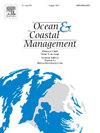Spatial-temporal characteristics of ship carbon emission based on AIS data
IF 4.8
2区 环境科学与生态学
Q1 OCEANOGRAPHY
引用次数: 0
Abstract
As the global shipping industry continues to expand, the environmental implications of ship carbon emissions are becoming increasingly apparent. Despite extensive analyses of carbon emissions from marine and coastal transportation vessels in existing research, studies on the precise measurement of carbon emissions from vessels in inland waterways and the spatiotemporal characteristics of carbon emission distribution remain limited. Addressing these emissions is essential, especially given the critical role that shipping plays in global trade. To accurately quantify emissions, the Ship Automatic Identification System (AIS) serves as a powerful tool, offering precise tracking of ships' routes, operational statuses, and activities in real time. This study leverages AIS data collected from the Suzhou segment of the Beijing-Hangzhou Grand Canal, spanning from 2018 to 2023, to perform a meticulous analysis of carbon emissions over this six-year period. By applying a bottom-up Systematic Transportation and Environmental Assessment Model (STEAM), this study provides a robust and detailed estimation of emissions, allowing for a comprehensive examination of the environmental impact. Based on the calculation of Moran's I index, the analysis delves into multiple dimensions of ship carbon emissions, embracing the lenses of ship types, operational statuses, region features, and spatial-temporal autocorrelation. The results indicate that over the six-year study period, the total carbon emissions from vessels are estimated to be approximately 146.86 metric tons, with cargo ships accounting for 64.1 % of the total emissions and vessels operating in cruise mode representing 67 %. Spatially, the findings reveal that areas with higher carbon emissions are predominantly concentrated near port regions serving as critical nodes within the shipping network. These spatial patterns observed point to the localized nature of these emissions, providing essential insights for regional policymakers and environmental regulators.
求助全文
约1分钟内获得全文
求助全文
来源期刊

Ocean & Coastal Management
环境科学-海洋学
CiteScore
8.50
自引率
15.20%
发文量
321
审稿时长
60 days
期刊介绍:
Ocean & Coastal Management is the leading international journal dedicated to the study of all aspects of ocean and coastal management from the global to local levels.
We publish rigorously peer-reviewed manuscripts from all disciplines, and inter-/trans-disciplinary and co-designed research, but all submissions must make clear the relevance to management and/or governance issues relevant to the sustainable development and conservation of oceans and coasts.
Comparative studies (from sub-national to trans-national cases, and other management / policy arenas) are encouraged, as are studies that critically assess current management practices and governance approaches. Submissions involving robust analysis, development of theory, and improvement of management practice are especially welcome.
 求助内容:
求助内容: 应助结果提醒方式:
应助结果提醒方式:


